Discover Florida Nature
It's time to explore the natural Florida


|
|
|
|
|
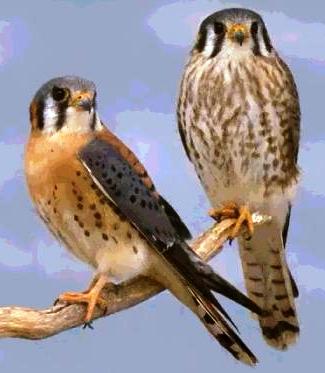 American
Kestrel- As engaging a bird as you'll ever see, the kestrel is
the smallest and most common of the falcons. Two subspecies of American
kestrel (Falco sparverius) occur in Florida: a northern subspecies (Falco
sparverius sparverius) that winters here between September and April,
and a resident, non-migratory subspecies, the southeastern American
kestrel (Falco sparverius paulus). Kestrels seen in Florida during
May-June are resident southeastern American kestrels. The back and tail
of the kestrel are russet, the wings blue-gray. Two lines of onyx tears
mark the sides of its white face. American kestrels nest in cavities
that they do not excavate. Instead, they must depend on
woodpeckers and natural processes to
create holes in trees. Kestrels nest predominantly in dead but standing
longleaf pine trees, called snags, usually in the abandoned cavities of
pileated woodpeckers. American kestrels often perch on telephone wires
at the edge of a field or other open area. From this vantage they hunt
for insects (especially grass-hoppers and dragonflies), lizards and
small mammals. Sometimes they are seen hovering like helicopters above
their prey. American
Kestrel- As engaging a bird as you'll ever see, the kestrel is
the smallest and most common of the falcons. Two subspecies of American
kestrel (Falco sparverius) occur in Florida: a northern subspecies (Falco
sparverius sparverius) that winters here between September and April,
and a resident, non-migratory subspecies, the southeastern American
kestrel (Falco sparverius paulus). Kestrels seen in Florida during
May-June are resident southeastern American kestrels. The back and tail
of the kestrel are russet, the wings blue-gray. Two lines of onyx tears
mark the sides of its white face. American kestrels nest in cavities
that they do not excavate. Instead, they must depend on
woodpeckers and natural processes to
create holes in trees. Kestrels nest predominantly in dead but standing
longleaf pine trees, called snags, usually in the abandoned cavities of
pileated woodpeckers. American kestrels often perch on telephone wires
at the edge of a field or other open area. From this vantage they hunt
for insects (especially grass-hoppers and dragonflies), lizards and
small mammals. Sometimes they are seen hovering like helicopters above
their prey. 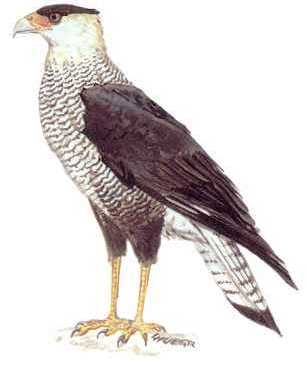 Crested
Caracara- The Crested Caracara has a body length of 19 - 23
inches, a 4-foot wingspan, and weighs 1 3/4 - 3 1/2 pounds. The bird’s
weight varies greatly depending on where it lives. The Crested
Caracaras’ preferred habitat is open, lowland countryside, like
pastures, savannas, river edges, and ranches of south-central Florida.
About the size of an osprey, this boldly patterned raptor has a crest,
naked face, heavy bill and longish neck and legs. A member of the falcon
family, the caracara is a strong flier but spends a lot of time on the
ground, scratching or digging for insects, or hunting around shallow
ponds or marshes for turtles, snakes, frogs or fish. Caracaras
occasionally eat larger animals such as
rabbits and cattle egrets and a pair will sometimes work together to
subdue these larger prey. Caracaras may also be spotted on fence posts
or utility poles along highways where they scan roadways for road-killed
raccoons,
opossums or
armadillos. Listed as
Threatened, the Crested Caracara is most abundant in a six-county
area north and west of Lake Okeechobee. Crested
Caracara- The Crested Caracara has a body length of 19 - 23
inches, a 4-foot wingspan, and weighs 1 3/4 - 3 1/2 pounds. The bird’s
weight varies greatly depending on where it lives. The Crested
Caracaras’ preferred habitat is open, lowland countryside, like
pastures, savannas, river edges, and ranches of south-central Florida.
About the size of an osprey, this boldly patterned raptor has a crest,
naked face, heavy bill and longish neck and legs. A member of the falcon
family, the caracara is a strong flier but spends a lot of time on the
ground, scratching or digging for insects, or hunting around shallow
ponds or marshes for turtles, snakes, frogs or fish. Caracaras
occasionally eat larger animals such as
rabbits and cattle egrets and a pair will sometimes work together to
subdue these larger prey. Caracaras may also be spotted on fence posts
or utility poles along highways where they scan roadways for road-killed
raccoons,
opossums or
armadillos. Listed as
Threatened, the Crested Caracara is most abundant in a six-county
area north and west of Lake Okeechobee. 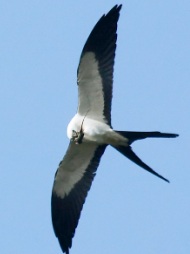 American
Swallow-tailed Kite-
The sight of a swallow-tailed kite is unforgettable: a black-and-white
raptor (bird of prey) with a deeply forked tail soaring through the
summer sky. Part of what awes you is the bird’s aerial grace as it
swoops and twists over the trees “hawking” insects. After spending the
fall and winter in South America, kites arrive in Florida in early March
to breed. They build nests of small sticks woven with Spanish moss,
preferably in tall cypress and pine. These trees emerge from a canopy of
prey-rich woodlands, like those of swamps
and savannas. Highly social for a raptor, they nest in loose colonies
and often forage in small flocks. The kites eat all kinds of insects and
small animals, including
frogs, anoles and
snakes. By early July, they begin to
gather in large communal roosts for the migration back to South America. American
Swallow-tailed Kite-
The sight of a swallow-tailed kite is unforgettable: a black-and-white
raptor (bird of prey) with a deeply forked tail soaring through the
summer sky. Part of what awes you is the bird’s aerial grace as it
swoops and twists over the trees “hawking” insects. After spending the
fall and winter in South America, kites arrive in Florida in early March
to breed. They build nests of small sticks woven with Spanish moss,
preferably in tall cypress and pine. These trees emerge from a canopy of
prey-rich woodlands, like those of swamps
and savannas. Highly social for a raptor, they nest in loose colonies
and often forage in small flocks. The kites eat all kinds of insects and
small animals, including
frogs, anoles and
snakes. By early July, they begin to
gather in large communal roosts for the migration back to South America.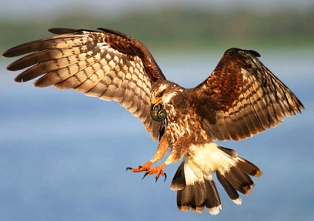 Florida
Snail Kite-
The Florida snail kite is aptly named – it feeds almost exclusively on
apple snails and, in the United States, is found only in Florida.
Historically, snail kites were found from the Everglades to just
southeast of Tallahassee, but wetland drainage and development
eliminated or altered its shallow freshwater foraging habitat. The
species was listed as endangered in 1967. Today, the population is
considered to be stable, but extremely vulnerable to the stresses of
habitat loss, prolonged droughts and anything that affects the
availability of apple snails, its primary food. Snail kites breed from
December to August and lay an average of three eggs in bulky nests built
in a variety of wetland trees, shrubs and emergent vegetation. During
the nesting season, the birds are usually found singly or in pairs; in
winter, they often roost together in communal groups. Generally, the
species is somewhat nomadic, moving from wetland to wetland in search of
snails. Florida
Snail Kite-
The Florida snail kite is aptly named – it feeds almost exclusively on
apple snails and, in the United States, is found only in Florida.
Historically, snail kites were found from the Everglades to just
southeast of Tallahassee, but wetland drainage and development
eliminated or altered its shallow freshwater foraging habitat. The
species was listed as endangered in 1967. Today, the population is
considered to be stable, but extremely vulnerable to the stresses of
habitat loss, prolonged droughts and anything that affects the
availability of apple snails, its primary food. Snail kites breed from
December to August and lay an average of three eggs in bulky nests built
in a variety of wetland trees, shrubs and emergent vegetation. During
the nesting season, the birds are usually found singly or in pairs; in
winter, they often roost together in communal groups. Generally, the
species is somewhat nomadic, moving from wetland to wetland in search of
snails.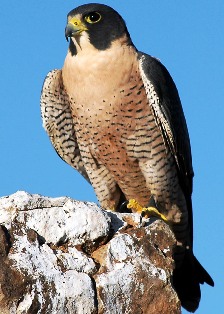 Peregrine
Falcon- Agility, speed, power - these are fitting adjectives
describing the flight of the peregrine falcon, the world's fastest bird.
This skillful hunter, famous for its ability to snatch birds right out
of the sky, has awed many a bird watcher fortunate enough to witness its
stooping flight- the term used to describe this bird's steep downward
plunge, with wings partially closed, at speeds that can exceed 150 mph.
Such deadly stealth is effective on doves, shorebirds and ducks, the
peregrine's favorite prey. Peregrine falcons don't breed in Florida, but
like many northern breeders, some spend the winter here. They are
regularly spotted during spring and fall migrations as they move between
northern breeding grounds and wintering areas in Central and South
America. Peregrine
Falcon- Agility, speed, power - these are fitting adjectives
describing the flight of the peregrine falcon, the world's fastest bird.
This skillful hunter, famous for its ability to snatch birds right out
of the sky, has awed many a bird watcher fortunate enough to witness its
stooping flight- the term used to describe this bird's steep downward
plunge, with wings partially closed, at speeds that can exceed 150 mph.
Such deadly stealth is effective on doves, shorebirds and ducks, the
peregrine's favorite prey. Peregrine falcons don't breed in Florida, but
like many northern breeders, some spend the winter here. They are
regularly spotted during spring and fall migrations as they move between
northern breeding grounds and wintering areas in Central and South
America. |
|
|
Advertise | Privacy Statement | Dog Encyclopedia | Video |Contact | Alaska Nature |
|